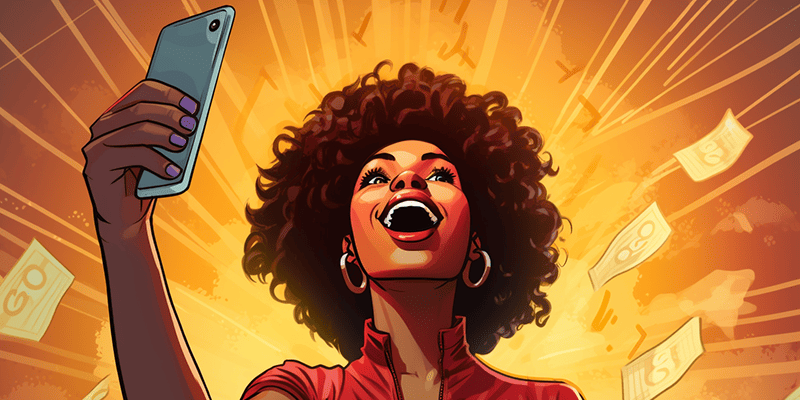
Our team, led by R.J. Weiss, CFP®, evaluated dozens of debt payoff apps based on our personal experiences, affordability, user experience, app store ratings, and effectiveness in helping users pay off debt successfully. After extensive research, we’ve selected our top picks for various categories:
- Best for keeping track of debt: Debt Payoff Planner
- Best for budgeting: YNAB
- Best for debt consolidation: Bright Money
- Best for automating debt payments: Qapital
- Best for free cash advances: Earnin
- Best for improving your credit score: Credit Karma
Note that the rating and review data contained in this article was collected on July 15, 2024. We update this data periodically throughout the year.
Best for Keeping Track of Debt: Debt Payoff Planner

- Cost: Free, or $2 per month for the Pro version.
- Availability: Web, Android and iOS.
- Google Play rating: 4.5/5 with 3,819 reviews.
- iOS App Store rating: 4.7/5 with 5,470 reviews.
Debt Payoff Planner provides a simple setup and review system to give you a comprehensive look at your debts and repayment journey. You can use it to see your obligations from every angle, including how much progress you’ve made toward becoming debt-free and how different payback strategies may speed up that process.
The app is broken up into four intertwined sections: debts, strategy, payoff plan and tracking. It collects information about your debts — including balances, APRs, minimum payments due and payoff progress — and uses that information to feed the other three sections.
You pick a strategy for your payoff plan (research shows the debt snowball method will give you the highest chance of success), and the Debt Payment Planner will show you how it impacts the time you’ll be paying on any or all of your debts.
As you make payments, you’ll enter them into the tracking section, which will also update your estimated payoff and debt-free dates.
You can track information about the money you owe either by individual debt or collectively.
Debt Payoff Planner also presents this graphically, with charts showing total debt balance by type, individual debt balance and payoff timelines.
Bottom line: Use Debt Payoff Planner if you need help keeping track of your credit and loan accounts, as well as when (and how much) to pay them. You can also check out our debt-payoff guide to learn about science-backed strategies for getting out of debt fast.
Best for Budgeting: YNAB

- Cost: $9.08/month if you pay $109 upfront once a year or $14.99 if paid monthly.
- Availability: Web, Android and iOS.
- Google Play rating: 4.7/5 with 19,893 reviews.
- iOS App Store rating: 4.8/5 with 52,770 reviews.
You Need a Budget, or YNAB, helps you reduce expenses by asking you to give every dollar a job.
That means you assign every dollar to a category in your spending plan. Creating this plan is an excellent first step to reducing expenses because it forces you to think through where your money needs to go. This process is bound to make it clear where you’re overspending.
YNAB’s income vs. expense reports are another great way to examine your spending and trim the fat.
Along with these reports, YNAB creates visualizations of how your expenses balance out each month, enabling you to see at a glance where you’re spending the most money. This is another way the app puts what you’re spending front and center so you can determine what needs to be cut or whether you have monthly bills that need to be renegotiated.
Bottom line: YNAB’s rule-based approach, expense tracking, and reporting features can help you better understand and control your spending, making it an excellent choice if you need to reduce expenses and free up more money for debt repayment.
Best for Debt Consolidation: Bright Money

- Cost: $8.08 per month billed annually ($97 upfront), or $14.99 if paid monthly.
- Availability: Android and iOS.
- Google Play rating: 4.7/5 with 68,385 reviews.
- iOS App Store rating: 4.8/5 with 134,572 reviews.
Bright Money offers a low-interest line of credit to consolidate your credit card debts — and you can get it regardless of your credit score. It then uses automation to transfer small amounts of money into your account every few days to ensure you make your payments on time.
Bright Money’s low-interest line of credit can potentially save you money over time by consolidating high-interest credit card debt into a lower-interest loan. In the example below, we’ll use Bright Money’s sample APR of 9.95% (though actual rates range from 9% to 29.99%, depending on factors like your credit score and income), with a maximum credit line of $10,000 and a five-year repayment period. Note that Bright Money’s APR is variable and will adjust with changes to the prime rate.
Now, let’s compare this with a typical high-interest credit card debt scenario:
| Credit Card Balance | Minimum Payment | APR | Total Paid | |
| Credit Card #1 | $5,000 | $100 | 23.99% | $8,766.64 |
| Credit Card #2 | $5,000 | $100 | 20.99% | $8,143.53 |
| Total Paid: | $16,910.17 |
With Bright Money, these high-interest cards are converted into a single loan. Here’s what paying those credit cards back could look like:
| Loan Amount | Minimum Payment | APR | Total Paid |
| $10,000 | $200 | 9.95% | $12,492.45 |
While you would save $4,417 in the example above, be mindful that a debt consolidation loan has its risks. It’s not uncommon for those who take on a debt consolidation loan to build up more credit card debt after the fact. When that happens, they’re left with both the personal loan and the high-interest credit card debt to pay off.
Bright Money also offers debt payment automation, using its MoneyScience algorithm to make payments based on your income, spending, upcoming bills, and other factors. This tool is available without taking out a debt consolidation loan. It moves small, manageable amounts of cash to your Bright Money Stash account, and then uses those funds to ensure you make your payments on time.

Bright Money leverages the debt avalanche method by default to pay back your credit cards, but you can change the order if you want to use the debt snowball method instead.
Bottom line: Use Bright Money for a lower overall interest rate on your credit cards and to ensure on-time payment. Learn more in our Bright Money review.
Best For Automating Your Debt Payments: Qapital

- Cost: $3 to $12 per month, depending on account type.
- Availability: Web, Android and iOS.
- Google Play rating: 4.3/5 with 21,627 reviews.
- iOS App Store Rating: 4.8/5 with 84,584 reviews.
Instead of paying off debts directly, Qapital lets you set personalized rules to save money for a designated debt goal. You can choose from options like recurring transfers (automatically set aside a fixed amount on a regular schedule), Round-Up (automatically save spare change by rounding up each purchase to the nearest dollar), and the Credit Card Rule (save a percentage of each credit card purchase, like 5% or 10%, which is then moved to your savings goal).
This “set-it-and-forget-it” approach helps you consistently set aside funds without extra effort. When it’s time to make a debt payment, you’ll need to manually transfer the saved funds to your payment account—unless you use Qapital as your primary bank, in which case you can pay directly from your Qapital Spend account.
For student loans, however, Qapital’s Debt Wrangler takes a more hands-on approach. It consolidates loan information, helps you pick a repayment strategy, and even automates payments. Debt Wrangler also includes refinancing options, credit score tools, and up to $1M in identity theft protection.
Qapital’s bank account option also includes an auto-debit feature, which can potentially save up to 0.25% on student loan interest rates. However, the interest rate is just 0.05%.
Bottom line: Qapital is a good fit if you like setting up creative savings challenges and automating your way to debt repayment. Just keep in mind that it doesn’t earn interest, so it’s best for short-term savings goals rather than holding large amounts of cash.
Best for Cash Advances: Earnin

- Cost: Free to use, with an option to tip. Instant transfers through the Lightning Speed service cost $3.99 for transfers of $100 or less and $5.99 for transfers over $100, though some qualifying accounts may see lower fees.
- Availability: Android and iOS.
- Google Play rating: 4.6/5 with 245,434 reviews.
- iOS App Store rating: 4.7/5 with 287,283 reviews.
Earnin offers a cash advance service without charging you interest or fees. It allows you to take money from your paycheck ahead of payday and provides an alternative to using your credit card to get by during times of financial stress.
Earnin’s cash advance limit is the highest on the market at $500, though you must work up to that figure. When you first get the app, you’re limited to $100 advances until you establish an income and repayment record. As you build a positive history, your maximum advance per pay period will increase and you can begin to borrow in larger increments.
When you get an advance, it will transfer within one to three days unless you use the paid Lightning Speed feature, which costs up to $3.99 (depending on how you want to receive your funds). When using Lightning Speed, you’ll get your cash advance within minutes.
Another interesting feature Earnin offers is “Automagic Earnings,” which can calculate your daily earnings and add them to your account. This only works if you’re employed in an office outside your home, don’t travel, and can bring your smartphone inside. It uses your location to determine whether you’re at work and how much to add to your account.
Bottom line: Use Earnin if cash advances can keep you from using credit cards while you wait for your next paycheck. You can learn more and see other options in our list of the best cash advance apps.
Best for Improving Your Credit Score: Credit Karma

- Cost: Free.
- Availability: Web, Android and iOS.
- Google Play rating: 4.7/5 with 2,924,275reviews.
- iOS App Store rating: 4.8/5 with 6,998,100 reviews.
Credit Karma’s credit monitoring services help you improve and protect your credit score. Improving your score can help you get better APRs on new loans and credit cards, negotiate better terms with your current lenders, and decrease the time it takes to pay your debts.
The credit scores and reports provided by the company are from Equifax and TransUnion. With these, you can arm yourself with information about what is positively and negatively affecting your credit score and plan meaningful action to improve it.

Credit Karma looks for differences between your TransUnion and Equifax credit reports that might suggest fraud or error, both of which can tank your credit if ignored. If it finds something of note, Credit Karma will send you an alert. The company can also help you dispute the credit bureaus’ errors.
Bottom line: We ranked Credit Karma #1 on our list of the best free credit score apps because you can use it help improve your credit to get better deals on loans and credit cards. Learn more in our Credit Karma review.
Best Debt Payoff Apps: Summary & Final Thoughts
According to the Federal Reserve Bank of New York, Americans have $16.51 trillion in debt. So it’s no surprise if you’ve accrued some of your own.
It seems like every type of debt is on the rise — mortgage, home equity and credit cards are just some that have shown sharp increases nationwide in recent years, and while student loans have actually decreased in total share of the national debt, they still represent over $1.5 trillion of it.
Fortunately, there are as many ways to stop owing money and live debt-free as there are types of debts, some of which are more straightforward than others. Whether it’s through careful tracking, reducing expenses, automation, consolidation or just a shot in the arm here and there, these debt payoff apps can help you speed up the process of debt reduction.






